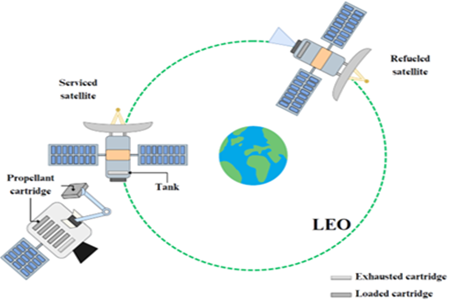Key technical advances and strategic analyses mark a successful start to the development of modular electric propulsion building blocks.
Published on 31 December 2024 | News
The BOOST project has completed its first year with substantial progress toward enabling iodine-based electric propulsion for SmallSat missions. The consortium has made advancements across technical development, diagnostics, and mission feasibility assessment—each of which supports the project’s long-term objective to provide scalable, modular propulsion systems compatible with on-orbit servicing and refueling.

Mission Analysis & Use Cases
The activity led by ASTOS focused on an in-depth mission analysis for different orbital regimes—Sun-Synchronous Orbits (SSO), Very Low Earth Orbits (VLEO), LEO constellations, MEO, and GEO missions. The analysis highlighted the potential benefits of iodine propulsion for orbit maintenance, collision avoidance, and especially for on-orbit refueling strategies.
Servicing concepts involving satellite constellations were also explored, including transfer dynamics, maneuver timelines, and economic trade-offs. VLEO scenarios, in particular, showed potential for enhanced performance through elliptical orbit strategies, albeit with challenges related to drag, atomic oxygen exposure, and system responsiveness.
Building the Propulsion Ecosystem
During its first year, BOOST initiated also the development of all key building blocks needed for scalable iodine propulsion systems, based on the requirements and the interface definitions provided by the guidance of TYVAK:
RF Cathode Development: The University of Padova advanced the design of an optimized RF cathode suitable for iodine operation. Numerical simulations based on Particle-in-Cell models and global plasma models have been validated and are guiding the prototype design. These cathodes promise longer lifetime, lower contamination, and compatibility with multiple propellants.
Rechargeable Iodine Tank: A prototype of a solid iodine storage system has been designed by the University of Bologna, featuring a cartridge-based architecture for on-orbit refueling. Early thermal-vacuum tests have shown reliable sublimation behavior, with active thermal control enabling precise mass flow delivery.
Iodine-Compatible Fluidics: Building on REGULUS heritage, T4i is refining a microfluidic subsystem capable of delivering iodine vapor at mass flow rates an order of magnitude above previous implementations. Material compatibility, actuator design, and additive manufacturing optimization are key focus areas.
Diagnostics & Testing Infrastructure: At the University of Stuttgart and CNRS, extensive upgrades are underway to adapt test facilities and instrumentation for iodine plasma characterization. Langmuir and Faraday probes, retarding potential analyzers, laser absorption spectroscopy (LAS), and laser-induced fluorescence (LIF) are being developed and tested for iodine environments.
These first-year results mark a solid step toward the realization of modular, scalable, and serviceable iodine propulsion systems, supporting more efficient and sustainable satellite operations in the coming decade.
📎 Stay tuned for more updates and experimental milestones as BOOST enters its second year of development.